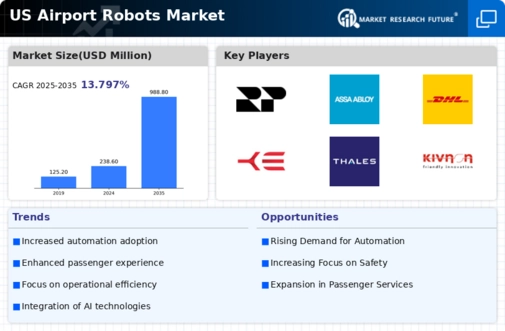The US Airport Robots Market has been witnessing significant developments in recent years, driven by the increasing demand for automation and technological advancements within the aviation sector. As airports strive to enhance operational efficiency, improve customer experience, and address labor shortages, the adoption of robotics solutions has accelerated. Various players have emerged in this market, offering solutions ranging from baggage handling and passenger assistance to security monitoring and cleaning services. The competitive landscape is characterized by a mix of established technology firms, innovative startups, and niche players, all vying to capture market share and provide value-added services to airport operators.
As the landscape evolves, understanding the strengths, market presence, and strategic initiatives of key players is indispensable to gauge future trends and opportunities.Robotics Plus has carved out a notable position within the US Airport Robots Market by emphasizing innovation and cutting-edge technology. The company specializes in developing advanced robotic solutions catering specifically to the demands of airport operations, focusing on enhancing productivity and operational efficiencies. Robotics Plus is recognized for its robust research and development capabilities, allowing it to stay ahead of competitors in creating intelligent automated systems.
The company's strengths are amplified by its commitment to user-centered design, ensuring that solutions are not only technologically advanced but also user-friendly. Additionally, Robotics Plus benefits from strategic partnerships and collaborations within the industry, enabling it to expand its market presence and leverage technological synergies with other influential players in the field. ASSA ABLOY has established itself as a prominent leader in the US Airport Robots Market with a suite of solutions that enhance security and accessibility within airport environments.
The company's key products and services focus on advanced access control systems and automated gates that seamlessly integrate with existing airport infrastructure. ASSA ABLOY's strengths lie in its extensive portfolio of innovative technologies and its ability to provide customized solutions tailored to specific airport requirements. The company's market presence is reinforced by its strong brand reputation and long-standing relationships with airport authorities and operators across the US.
Furthermore, ASSA ABLOY has undertaken strategic mergers and acquisitions to bolster its technological capabilities and expand its reach within the airport sector, positioning itself as a one-stop solutions provider for airports seeking enhanced security and operational efficiency. With a clear focus on addressing the challenges faced by modern airports, ASSA ABLOY continues to play a vital role in driving the evolution of robotics in the aviation industry.






















